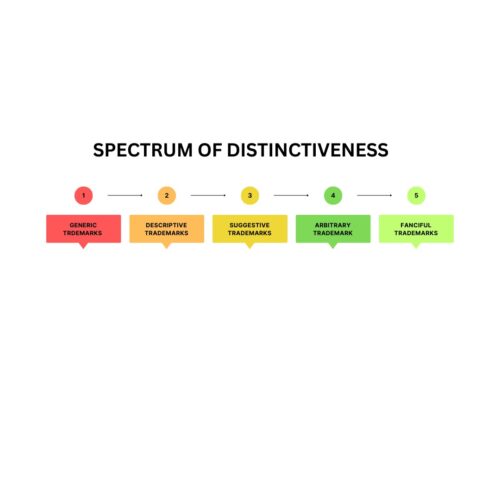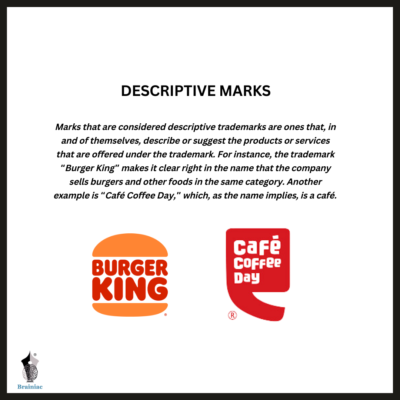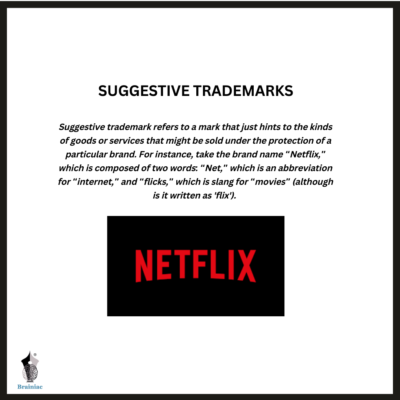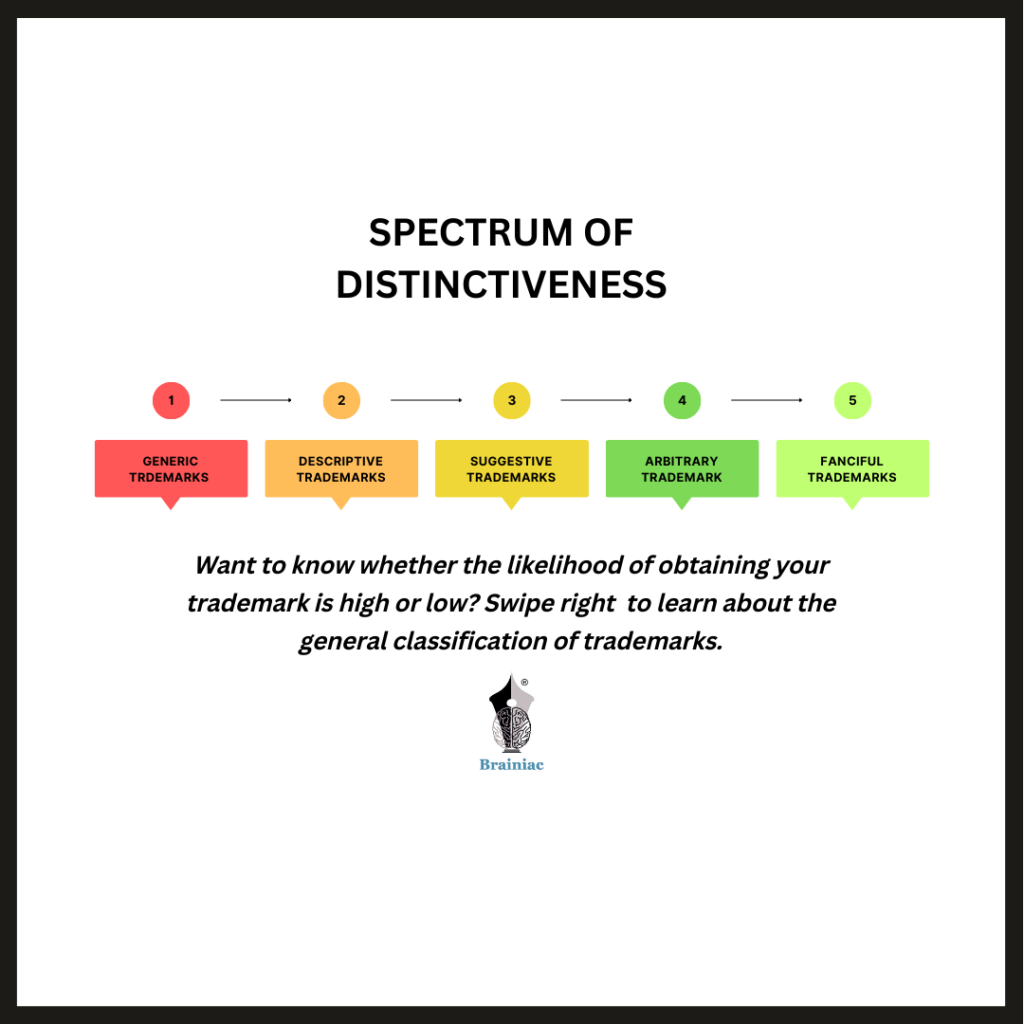Introduction
Along with the protection against counterfeiting or the unauthorized use of trademarks by non-proprietors, another purpose of the trademark law is to save the consumers from the likelihood of confusion that might divert them from making an informed decision while purchasing any product or availing any service. This is the reason why all trademarks that have been applied for don’t make it to the registration. People are not allowed to simply replicate already established trademarks or make minor alterations in order to use them. Instead, they are required to come up with their own unique trademarks, which force them to utilize their creativity.
While some trademarks have zero probability of being registered, others have great registration potential. This method of differentiating the various types of trademarks is referred to as the “Spectrum of Distinctiveness”, and the same concept will be discussed in greater depth in the following article.
Classification of Trademarks
The spectrum divides trademarks into five types: generic, descriptive, suggestive, arbitrary, and imaginative. These trademarks are ranked from least likely to most likely to be registered. Let us discuss each category in depth-

Generic Trademarks
 Generic trademarks are those that are composed of words that are used often in day-to-day life and that are unable to differentiate the goods of one company from those of another. For instance, a person who sells milk cannot name his store “Milk” since not only is this name obviously generic, but it would also monopolize the use of a regularly used dictionary term ‘Milk. Generic trademarks have almost no chance of being registered because they fail to achieve the ‘distinctiveness’ that is required of a trademark. In addition, generic trademarks seek to monopolize dictionary terms by stifling creative expression.
Generic trademarks are those that are composed of words that are used often in day-to-day life and that are unable to differentiate the goods of one company from those of another. For instance, a person who sells milk cannot name his store “Milk” since not only is this name obviously generic, but it would also monopolize the use of a regularly used dictionary term ‘Milk. Generic trademarks have almost no chance of being registered because they fail to achieve the ‘distinctiveness’ that is required of a trademark. In addition, generic trademarks seek to monopolize dictionary terms by stifling creative expression.
However, you may come across some generic trademarks in the market that are registered. The catch is that in order to get a generic trademark registered, the proprietor must demonstrate that his trademark has acquired a secondary meaning in the market due to its widespread use and that, despite being generic; the trademark has gained distinctiveness in the market.
Descriptive Trademarks
 Marks that are considered descriptive trademarks are ones that, in and of themselves, describe or suggest the products or services that are offered under the trademark. For instance, the trademark “Burger King” makes it clear right in the name that the company sells burgers and other foods in the same category. Another example is “Café Coffee Day,” which, as the name implies, is a café. If a descriptive mark has already been in use or has developed a secondary meaning in the industry, there is a probability that it will be registered as a trademark.
Marks that are considered descriptive trademarks are ones that, in and of themselves, describe or suggest the products or services that are offered under the trademark. For instance, the trademark “Burger King” makes it clear right in the name that the company sells burgers and other foods in the same category. Another example is “Café Coffee Day,” which, as the name implies, is a café. If a descriptive mark has already been in use or has developed a secondary meaning in the industry, there is a probability that it will be registered as a trademark.
Suggestive Trademarks
 Suggestive trademark refers to a mark that just hints to the kinds of goods or services that might be sold under the protection of a particular brand. For instance, take the brand name “Netflix,” which is composed of two words: “Net,” which is an abbreviation for “internet,” and “flicks,” which is slang for “movies” (although is it written as ‘flix’). As a result, it is not immediately obvious from the name what kind of service is provided here.
Suggestive trademark refers to a mark that just hints to the kinds of goods or services that might be sold under the protection of a particular brand. For instance, take the brand name “Netflix,” which is composed of two words: “Net,” which is an abbreviation for “internet,” and “flicks,” which is slang for “movies” (although is it written as ‘flix’). As a result, it is not immediately obvious from the name what kind of service is provided here.
The sole difference between a suggestive mark and a descriptive mark is that the latter encourages customers to think about and reflect on the potential categories of goods or services that are being offered, while the former simply specifies the goods that are being sold. The possibilities of registering the suggestive marks are higher than those for the two types of marks that were discussed earlier.
Arbitrary Trademarks
 Arbitrary marks are those that are used in relation to items or services that are not in any way related to one another. “Jaguar” is a well-known example of an arbitrary trademark. Although Jaguar is the name of an animal, the name is used as a trademark to sell premium automobiles. Another illustration of this would be the word “Apple,” which originally referred to a fruit but is now more commonly associated with the well-known electronic retailing corporation. The most likely to be registered are arbitrary trademarks.
Arbitrary marks are those that are used in relation to items or services that are not in any way related to one another. “Jaguar” is a well-known example of an arbitrary trademark. Although Jaguar is the name of an animal, the name is used as a trademark to sell premium automobiles. Another illustration of this would be the word “Apple,” which originally referred to a fruit but is now more commonly associated with the well-known electronic retailing corporation. The most likely to be registered are arbitrary trademarks.
Fanciful Trademarks
 On the scale of distinctiveness, fanciful trademarks rank the highest on the spectrum. Fanciful marks include terms that have been invented or coined but do not have any meaning of their own and do not even exist in the dictionary. Some well-known examples of fanciful marks include Google, Kodak, and Adidas, to name just a few. Fanciful marks are the ones that can be registered the quickest and most easily without raising any objections from the registry.
On the scale of distinctiveness, fanciful trademarks rank the highest on the spectrum. Fanciful marks include terms that have been invented or coined but do not have any meaning of their own and do not even exist in the dictionary. Some well-known examples of fanciful marks include Google, Kodak, and Adidas, to name just a few. Fanciful marks are the ones that can be registered the quickest and most easily without raising any objections from the registry.
Takeaway for Businesses
In light of what has been discussed thus far, descriptive and generic terms have a slim to nonexistent probability of being registered until it is demonstrated that they have acquired a certain secondary meaning in the market. However, often, it is seen that developing businesses and entrepreneurs select either a descriptive or generic trademark in order to make it easier for customers to remember the name of the company. Yet, when applying for the registration of the same, this turns out to be a huge impediment in the way of acquiring registration. As a result, it is recommended that new businesses, as well as established companies, devote a suitable amount of time and resources to the process of coming up with a name that is suitable for registration.
#trademark #typesoftrademark #spectrumofdistinctiveness #arbitrary #generic #fanciful #suggestive #descriptive


